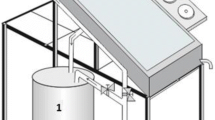Abstract
Intention, Goal, Scope, Background
Advanced oxidation processes are powerful methods which are capable of transforming refractory, nonbiodegradable and/or toxic organic compounds into harmless end products such as carbon dioxide and water. However, one commen problem of all advanced oxidation processes is the high demand of electrical energy for ultraviolet lamps, which causes high operational costs. Minimization of the required irradiation time, and therefore the energy consumption, by optimization of other reaction conditions such as catalyst-oxidant type and concentration, pH, temperature, pollutant/oxidant ratio etc., therefore continues to gain importance.
Objective
The main objective of this study was the minimization of the required irradiation time through optimization of the use of a newly patented catalyst, ferrioxalate, and also to compare the performance of this catalyst with the performance of other AOPs.
Methods
Oxidation of 4-chlorophenol by photo-Fenton process using potassium ferrioxalate as a mediator was studied in a lab scale photoreactor. The influence of parameters such as hydrogen peroxide and ferrioxalate concentrations, initial pH, power-output, oxalate/iron ratio and different iron sources was evaluated. An upflow photoreactor equipped with a 1000 Watt high-pressure mercury vapour lamp and operating in a recirculation mode was used during photodegradation experiments. The extent of the reduction of 4-chlorophenol, Total Organic Carbon and Chemical Oxygen Demand was used to evaluate the photodegradation reaction.
Results and Discussion
The optimum pH range observed was found to be 2.7-3. The efficiency of 4-chlorophenol oxidation increased with increasing concentrations of hydrogen peroxide and ferrioxalate, reaching a plateau after the addition of 10 and 0.072 mM of those reagents, respectively. Using an Oxalate/ iron ratio of 12 was 18% less efficient than using a ratio of 3:1. The efficiency increased with increasing radiation power. However, this increase was not linear. The UV/ferrioxalate/H2O2 process, by which complete mineralization of 100 mgl-1 4-chlorophenol was achieved in 20 min of total reaction time, was the most efficient process among the alternatives applied.
Conclusions
The use of ferrioxalate as the catalyst was found to be more efficient than the use of Fe(II) and Fe(III) iron species. It was possible to completely mineralize 4-chlorophenol.
Recommendation and Outlook
The results of this study demonstrate that the ferrioxalate-mediated degradation of 4-chlorophenol requires less irradiation times than other advanced oxidation processes. There are mainly 19 phenol isomers and other toxic and nonbiodegradable organic compounds. We recommend that similar studies should be performed on many such compounds in order to attain a clear understanding of the performance of this catalyst. Because of its light sensitivity, this catalyst should be used immediately after its preparation. The use of low pressure mercury vapour lamps in this process should also be considered, since low power outputs may be enough for the process.
Similar content being viewed by others
References
APHA, AWWA, WEF (1992): Standard methods for the examination of water and wastewater 5–30
Balzani V, Carassitti V (1970): Photochemistry of coordination compounds. Academic Press, London, 145 pp
Bigda RJ (1995): Consider Fenton’s chemistry for wastewater treatment. Chem Eng Progress 91 (12) 62–66
Fenton HJ (1894): Oxidation of tartaric acid in presence of iron. J Chem Soc 65, 899–904
Haber F, Weiss J (1934): The catalytic decomposition of hydrogen peroxide by iron salts. Proc R Soc A 147, 332–343
Hatchard CG, Parker CA (1956): A new sensitive chemical actinometer. II. Potassium ferrioxalate as a standard chemical actinometer. Proc R Soc (London) A 235, 518–536
Legrini O, Oliveros E, Braun AM (1993): Photochemical processes for water treatment. Chem Rew 93, 671–698
Nogueira RFP, Guimaraes JR (2000): Photodegradation of dichloroacetic acid and 2,4-dichlorophenol by ferrioxalate/H2O2 system. Wat Res 34 (3) 895–901
Nedolowjko A, Kiwi J (1997): Parameters affecting the homogeneous and heterogeneous degradation of quinoline solutions in light-activated processes. J Photochem Photobiol A: Chem 110, 149–157
Oliveros E, Legrini O, Hohl M, Müller T, Braun A (1997): Industrial waste water treatment: Large scale development of a light-enhanced Fenton reaction. Chem Eng Process 36, 397–405
Pignatello JJ (1992): Dark and photoassisted Fe3+-catalyzed degradation of chlorophenoxy herbicides by hydrogen peroxide. Environ Sci Technol 26, 944–951
Rush JD, Maskos Z, Koppenol WH (1990): Distinction between hydroxyl radical and ferryl species. Methods Enzymol 186, 148–157
Safarzadeh-Amiri A (1993): Photocatalytic method for treatment of contaminated water. S Patent No 5,266, 214
Safarzadeh-Amiri A, Bolton JR, Cater SR (1996): The use of iron in Advanced Oxidation Processes. J Advan Oxid Technol 1, 18–26
Safarzadeh-Amiri A, Bolton JR, Cater SR (1997): Ferrioxalate-mediated photodegradation of organic pollutants in contaminated water. Wat Res 31 (4) 787–798
Scheck CK, Frimmel FH (1995): Degradation of phenol and salicylic acid by ultraviolet radiation/hydrogen peroxide. Wat Res 29, 2346–2352
Sedlak DL, Andren AW (1991): Oxidation of chlorobenzene with Fenton’s reagent. Environ Sci Technol 25, 777–782
Sun Y, Pignatello JJ (1993): Photochemical reactions involved in the total mineralization of 2,4-D by Fe3+/H2O2/UV. Environ Sci Technol 27, 304–310
Zepp RG, Faust BC, Hoigne J (1992): Hydroxyl radical formation in aqueous reactions (pH 3-8) of iron(II) with hydrogen peroxide: The photo-Fenton reaction. Environ Sci Technol 26, 313–319
Author information
Authors and Affiliations
Corresponding author
Rights and permissions
About this article
Cite this article
Bali, U. Ferrioxalate-mediated photodegradation and mineralization of 4-Chlorophenol. Environ Sci & Pollut Res 10, 33–38 (2003). https://doi.org/10.1065/espr2002.10.134
Received:
Accepted:
Issue Date:
DOI: https://doi.org/10.1065/espr2002.10.134



